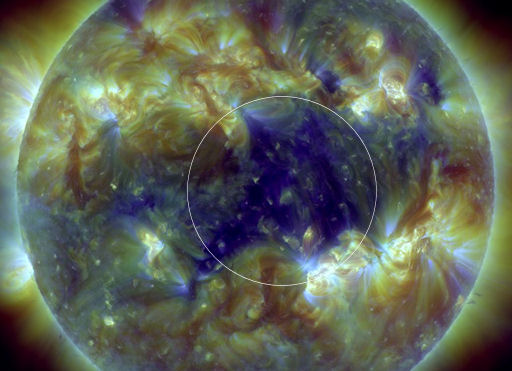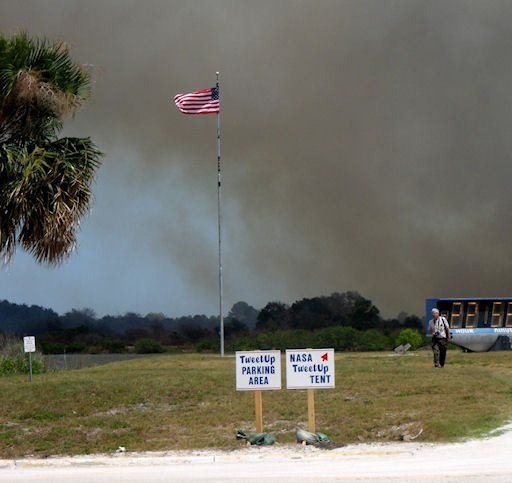They came from outer space--and you can have one! Genuine meteorites are now on sale in the Space Weather Store. | | |
VOYAGER'S SURPRISING MESSAGE TO E.T.: NASA's Voyager probes are at the edge of the solar system carrying a message to possible extraterrestrial civilizations. Highlights include greetings from humans and whales, some of Earth's greatest music, and the brainwaves of a young woman in love. Get the full story from Science@NASA.
CORONAL HOLE: NASA's Solar Dynamics Observatory is monitoring a hole in the sun's atmosphere--a "coronal hole." It is the dark region circled in this extreme ultraviolet image taken during the early hours of April 28th:

Above: A composite 171-193-211 Angstrom EUV image from SDO. April 28 @ 06:28 UT
Coronal holes are places where the sun's magnetic field opens up and allows the solar wind to escape. A stream of solar wind flowing from this coronal hole is expected to reach Earth on April 30th-May 1st. NOAA forecasters estimate a 35% chance of geomagnetic activity at that time.
April 2011 Aurora Gallery
[previous Aprils: 2010, 2009, 2008, 2007, 2006, 2005, 2004, 2003, 2002]
KENNEDY WILDFIRE: Forecasters say there is an 80% chance of favorable weather for Friday's scheduled launch of space shuttle Endeavour. The dark clouds over Kennedy Space Center that briefly worried onlookers yesterday were not rain, but smoke:

"Around noon on April 27th, smoke from a nearby wildfire appeared over the launch site," says photographer Jacob Kuiper, one of hundres of journalists on hand to cover the shuttle's liftoff. "The fire spread rapidly, driven by strong southerly winds along the Florida coastline. At one point, huge smoke clouds covered more than half of the skies over KSC. It was a dramatic scene."
Firefighters have the blaze under control, and it is not expected to interfere with an on-time liftoff at 3:47 pm EDT on April 29th.
Endeavour is poised to begin a two week mission to the International Space Station. There it will deliver the Alpha Magnetic Spectrometer--a $1.5 billion cosmic ray detector that could reveal the nature of dark matter and find whole galaxies made of antimatter. The shuttle crew will also test a new automated rendevous system named, appropriately, STORMM, that will help future spacecraft dock to the ISS after the shuttle program is over.
Get ready for Endeavour's last flight: Turn your cell phone into a field-tested shuttle tracker.
Potentially Hazardous Asteroids (
PHAs) are space rocks larger than approximately 100m that can come closer to Earth than 0.05 AU. None of the known PHAs is on a collision course with our planet, although astronomers are finding
new ones all the time.
On April 28, 2011 there were 1218 potentially hazardous asteroids.
Notes: LD means "Lunar Distance." 1 LD = 384,401 km, the distance between Earth and the Moon. 1 LD also equals 0.00256 AU. MAG is the visual magnitude of the asteroid on the date of closest approach. | | The official U.S. government space weather bureau |
| | The first place to look for information about sundogs, pillars, rainbows and related phenomena. |
| | Researchers call it a "Hubble for the sun." SDO is the most advanced solar observatory ever. |
| | 3D views of the sun from NASA's Solar and Terrestrial Relations Observatory |
| | Realtime and archival images of the Sun from SOHO. |
| | from the NOAA Space Environment Center |
| | the underlying science of space weather |
| | for out-of-this-world printing and graphics |

